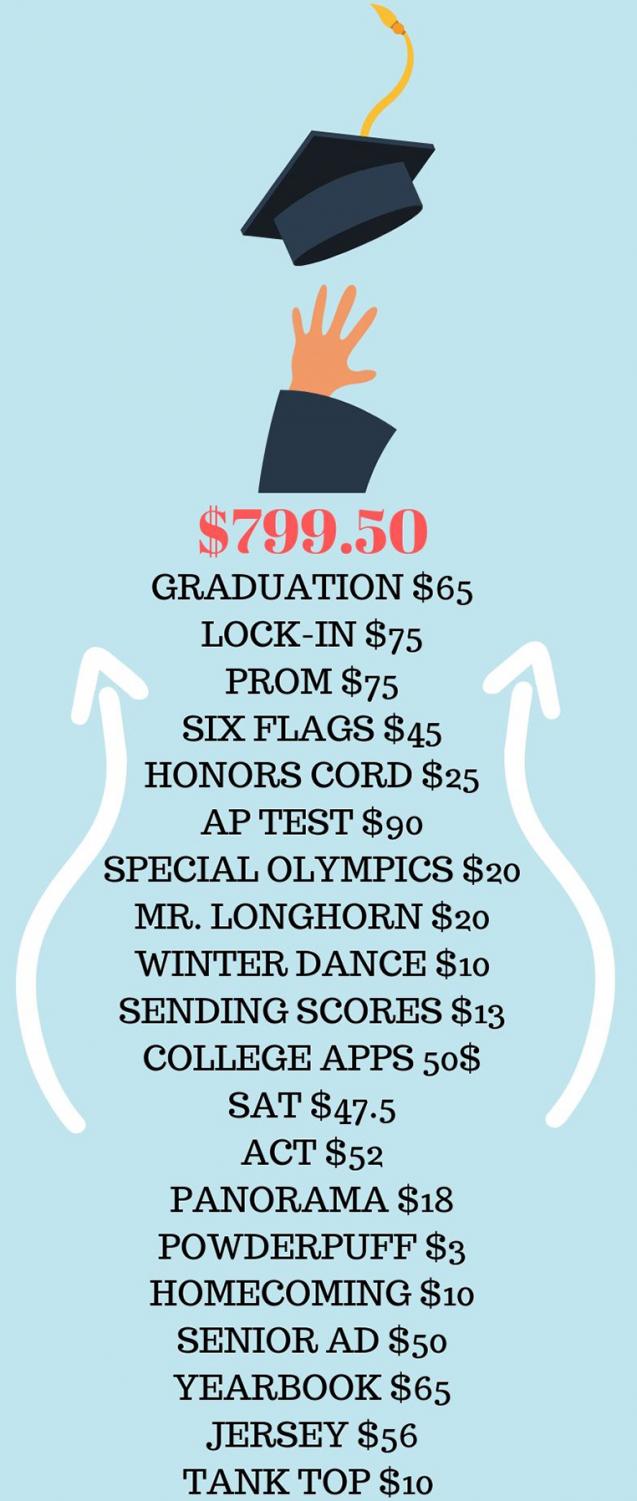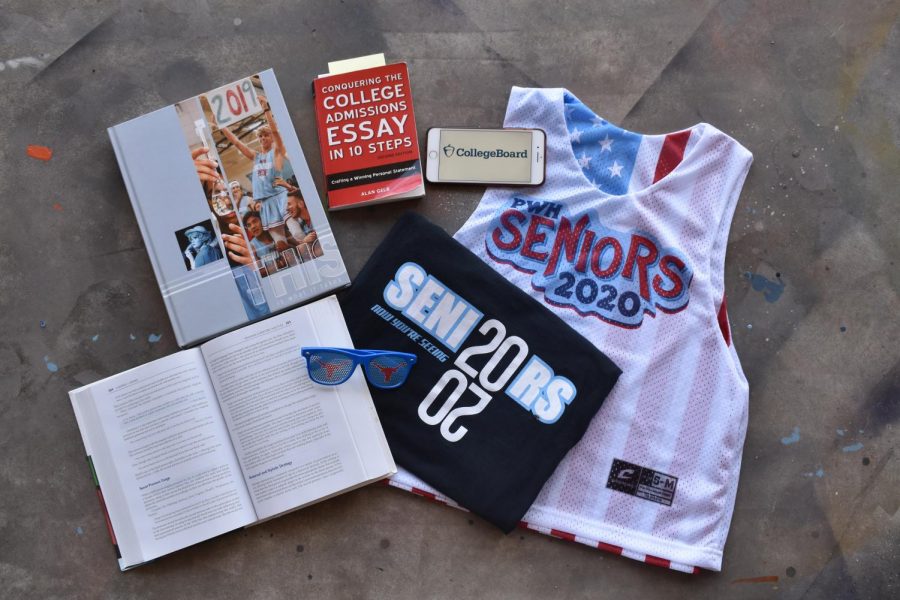Public education is free, right? Not exactly. The local taxpayer provides the funding for the education itself, but there is a litany of items and events, especially for seniors, that cost money–and lots of it. These dollar-guzzling opportunities range from senior traditions like Mr. Longhorn to the college application process.
The below graphic depicts an estimate of the cost that many seniors will pay throughout the school year. Not every senior participates in senior traditions like Powderpuff and Six Flags day, nor does every senior belong to an honor society, apply to a college with an application fee or even apply to college at all. According to college and career counselor Lauren Rowe, 72% of the graduating class of 2019 attended a four-year university.
That being said, the graphic only accounts for the cost of the following:
- one average-priced college application
- one fee to send standardized test scores to a college
- one SAT fee
- one ACT fee
Many students will apply to multiple colleges and take multiple standardized tests outside of the district-funded test. Because of these costs and others like it, some students with lower-income families are upset by these costs.

Graphic made on Canva
“I feel like the costs are not considered for kids who can’t afford things or whose parents don’t want them to buy things so they can save money,” an anonymous low-income senior said. “I didn’t buy a senior jersey because I didn’t want to spend that much money on a shirt that I’m probably never going to wear again. I would have to pay for it because my parents wouldn’t buy it for me because they’re trying to save money for my college.”
While college applications and costs can be stressful for all students seeking higher education, some families are more stressed than others about the financial aspect of college. There are programs that offer application and testing fee waivers to students on the Free and Reduced Lunch Program, but these waivers are limited.
“I’m trying to go into medical school, but it’s really expensive, and the schools that I’m applying to have application fees. If you qualify for free lunches, you automatically qualify for some fee waivers,” the anonymous senior said. “I think you get fee waivers for six schools and fee waivers for two or three ACTs or SATs outside of school. But, if you want to apply to more than six schools or take more than two or three tests, then you have to pay for those yourself.”
In regards to senior traditions, some students who cannot pay for Powderpuff, Mr. Longhorn, senior jerseys or other activities feel excluded from the fun of senior year.
“I feel a little bit left out because I won’t have a jersey, but I know I’m saving money,” the anonymous senior said. “It’s not that big of a deal for me, but I’m sure for students who want to be more involved in school than me, it would feel a lot worse. If every single one of your friends has it, but you don’t have it, you’d feel excluded.”
Not only do some of these seniors feel excluded from their class, but they often feel uncomfortable around their wealthier peers.
“It makes me uncomfortable because a lot of people don’t even give a second thought to that kind of stuff, while I’m thinking ‘Wow, I spent so much money on this,’” the anonymous senior said. “That thought is constantly in my head and being surrounded by people who don’t even give it a second thought makes me uncomfortable.”
More than their peers, these seniors have to learn to prioritize so that they can spend their money on what is most important to them and their families.
“It would be nice if people were more considerate of students who can’t pay for things because we have to save the money for other things,” the anonymous senior said. “$50 for a shirt versus $50 for a college application fee…I would rather spend that money on applying to college. Cost is constantly on my mind.”





![Smiling in a sea of Longhorns, Fox 2 reporter Ty Hawkins joins junior Darren Young during the morning Oct. 3 pep rally. The last time West was featured in this segment was 2011. “[I hope people see this and think] if you come to [Parkway] West, you will have the time of your life because there are so many fun activities to do that make it feel like you belong here. I was surprised so many people attended, but it was a lot of fun,” Young said.](https://pwestpathfinder.com/wp-content/uploads/2025/10/Edited2-1200x798.jpg)
![West High seniors and families listen as a representative of The Scholarship Foundation of St. Louis, Teresa Steinkamp, leads a Free Application for Federal Student Aid (FAFSA) workshop. This session, held in the library, provided guidance on financial aid, scholarships and student loan options. “This event is very beneficial for any seniors who are applying to or considering applying to colleges after high school [because] the cost of college is on the rise for seniors and parents,” college and career counselor Chris Lorenz said.](https://pwestpathfinder.com/wp-content/uploads/2025/09/DSC_4478-1200x778.jpg)
![Senior Kamori Berry walks across the field during halftime at the Homecoming football game on Sept. 12. During the pep assembly earlier that day, she was pronounced Homecoming Queen. “I thought it was nice that the crowd [started] cheering right away. I know [my friends] were really excited for me, and my family was happy because typically non-white people don't win,” Berry said.](https://pwestpathfinder.com/wp-content/uploads/2025/09/DSC7046-Enhanced-NR-1200x798.jpg)



![Pitching the ball on Apr. 14, senior Henry Wild and his team play against Belleville East. Wild was named scholar athlete of the year by St. Louis Post-Dispatch after maintaining a high cumulative GPA and staying involved with athletics for all of high school. “It’s an amazing honor. I feel very blessed to have the opportunity to represent my school [and] what [it] stands for,” Wild said.](https://pwestpathfinder.com/wp-content/uploads/2025/05/unnamed-6-1200x714.jpg)
![The Glory of Missouri award recipients stand with their certificates after finding out which virtue they were chosen to represent. When discovering their virtues, some recipients were met with contented confirmation, while others, complete surprise. “I was not at all surprised to get Truth. I discussed that with some of the other people who were getting the awards as well, and that came up as something I might get. Being in journalism, [Fellowship of Christian Athletes and] Speech and Debate, there's a culture of really caring about truth as a principle that I've tried to contribute to as well. I was very glad; [Truth] was a great one to get,” senior Will Gonsior said.](https://pwestpathfinder.com/wp-content/uploads/2025/04/Group-Glory-of-Missouri.jpg)

